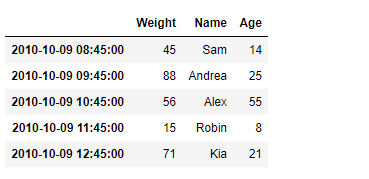Python| Pandas DataFrame.to_records
Pandas DataFrame 是一种二维大小可变的、潜在异构的表格数据结构,带有标记的轴(行和列)。算术运算在行标签和列标签上对齐。它可以被认为是 Series 对象的类 dict 容器。这是 Pandas 的主要数据结构。
Pandas DataFrame.to_records()函数将 DataFrame 转换为 NumPy 记录数组。如果请求,索引将作为记录数组的第一个字段包含在内。
Syntax: DataFrame.to_records(index=True, convert_datetime64=None, column_dtypes=None, index_dtypes=None)
Parameter :
index : bool, default True
convert_datetime64 : Whether to convert the index to datetime.datetime if it is a DatetimeIndex.
column_dtypes : If a string or type, the data type to store all columns
index_dtypes : If a string or type, the data type to store all index levels
Returns : numpy.recarray
示例 #1:使用DataFrame.to_records()函数将给定的 Dataframe 转换为 numpy 记录数组。
# importing pandas as pd
import pandas as pd
# Creating the DataFrame
df = pd.DataFrame({'Weight':[45, 88, 56, 15, 71],
'Name':['Sam', 'Andrea', 'Alex', 'Robin', 'Kia'],
'Age':[14, 25, 55, 8, 21]})
# Create the index
index_ = pd.date_range('2010-10-09 08:45', periods = 5, freq ='H')
# Set the index
df.index = index_
# Print the DataFrame
print(df)
输出 : 
现在我们将使用DataFrame.to_records()函数将给定的数据帧转换为 numpy 记录数组表示。
# convert to numpy record array
result = df.to_records()
# Print the result
print(result)
输出 : 
正如我们在输出中看到的, DataFrame.to_records()函数已成功地将给定的数据帧转换为 numpy 记录数组表示。示例 #2:使用DataFrame.to_records()函数将给定的 Dataframe 转换为 numpy 记录数组。
# importing pandas as pd
import pandas as pd
# Creating the DataFrame
df = pd.DataFrame({"A":[12, 4, 5, None, 1],
"B":[7, 2, 54, 3, None],
"C":[20, 16, 11, 3, 8],
"D":[14, 3, None, 2, 6]})
# Create the index
index_ = ['Row_1', 'Row_2', 'Row_3', 'Row_4', 'Row_5']
# Set the index
df.index = index_
# Print the DataFrame
print(df)
输出 : 
现在我们将使用DataFrame.to_records()函数将给定的数据帧转换为 numpy 记录数组表示。
# convert to numpy record array
result = df.to_records()
# Print the result
print(result)
输出 : 
正如我们在输出中看到的, DataFrame.to_records()函数已成功地将给定的数据帧转换为 numpy 记录数组表示。